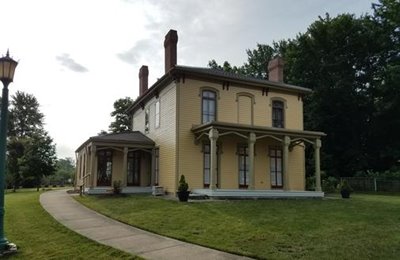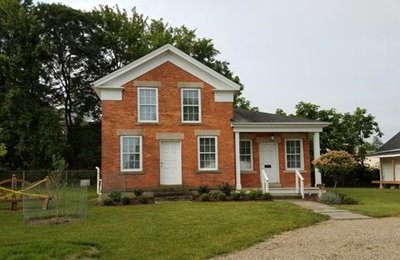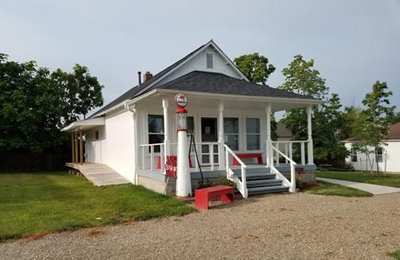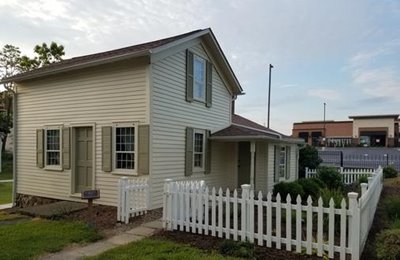Strongsville Historical Society and Village
 Historical Village Hours
Historical Village Hours
Located at 13305 Pearl Road, 1/4 mile north of Route 82 (Royalton Road)
Tours in 2022 are available May through August on the first Wednesday and third Saturday of the month between 10 a.m. and 1 p.m. Group tours are available by appointment. Call Valerie at (330) 952-1095 for information and to make reservations.
For more information call (440) 572-0057 or visit the
Strongsville Historical Society website
TOURS: $5 adults, $3 children 6 to 12 years
Special arrangements can be made for guided tours with special group rates. Visit the Olds General Store (which is open during society hours) for a fine selection of gifts such as: pottery, commemorative plaques, prints, mugs, note cards, Amish apple butter, old time candy and games, custom-designed Strongsville afghans, the Strongsville History Book, and much more!
Membership Opportunities
Senior $15 (all memberships are annual except lefetime)
Individual $25
Family $40
Student $10
Corporate $100
Lifetime memberships are available for $300
The Historical Society is a private non-profit organization.
Strongsville takes great pride in the preservation of its past as it moves forward into the future. Explore the history pages to learn more about the events that led to the founding and settlement of the city and how its history lives today.
If you wish to become a more active participant in the city's preservation, visit the Historical Society section for information on membership opportunities, meeting date and society hours.
 Did you know...
Did you know... John S. Strong, a native New Englander for whom the township of Strongsville was named, arrived in 1816, the year there was no summer due to a volcanic explosion in 1815, of the volcano Tombora.
Did you know... the Strongsville Commons was given to the residents on April 1, 1821, by John S. Strong for one dollar. The commons celebrated its 175th anniversary in 1991.
The Founding of Strongsville
In the early 1800's, lands in northeastern Ohio belonging to the state of Connecticut and called the "Western Reserve" began to attract emigration from Connecticut, Vermont and other parts of New England. These lands were sold by the state to the Connecticut Land Company and parceled out among the members of the organization. Township No. 5, in the 14th range fell to the ownership of Oliver Ellsworth of Hartford. The land was inherited by his sons, William W. and Henry L. of Windsor & Hartford, Connecticut.
In 1815, the Ellsworths began a correspondence with John Stoughton Strong of Marlboro, Vermont regarding sale of a considerable portion of their Ohio township. Agreements were made to purchase some of the Ellsworth land and to act as an agent for the sale of the balance of the land.
In February 1816, John led a party through New York with a stop in Cleveland. They followed a trail south along the Rocky River to Columbia. From Columbia they traveled to Township No. 5. They cleared about an acre and built log cabins for shelter. The party included John's oldest son Emory, his brother-in-law, Elijah Lyman, Sr., and Guilford Whitney, a relative of John's wife. Guilford's 21 year old daughter Bernicey served as cook and cabin keeper for the men. With her one year old daughter Eliza, they constituted the entire female society of the settlement. Also part of the group were William Fuller Jr., Obadiah Church, Zachariah Goodale and George Gilbert. Their relationship to the others in the party is not known.
Following the building of shelters, the major task was surveying the land. The township was surveyed into 100 lots of 160 acres each. Of the land in No. 5, the larger part was either bought by Strong or sold by him for the Ellsworths. Sales to him and others were mostly made on a money basis at a price of $2.50 per acre. Under contract with the Ellsworths, Strong was to purchase 7 lots of 160 acres each in No. 5 at $1.50 per acre in consideration of his selling 21 other lots within a year at $2.50 per acre. He collected his commissions in advance and applied that to the purchase of his lots. The contract also provided that Mr. Strong cut a "good and sufficient road" through the center of the township. The Ellsworths were to pay for surveying the town into lots. trying to post
Immigration into the township blossomed with the arrival of many new families. In 1818, Strong moved his family to Ohio and occupied a log house prepared for them just north of the center of No.5.
The area became an official township on February 25, 1818 and was named Strongsville. In 1819, a log cabin was built on the southeast corner of the commons. It served as a schoolhouse, church, and town hall. In 1822, the township was divided into five school districts, and later into ten districts. By 1826, the township had increased to 89 households. Strongsville became a village in 1923 and became a city in 1961.
Mr. Strong was a leading entrepreneur of the settlement. He sought to bring people with skills into the area, such as a town doctor following the death of the original town's doctor, Strong's son-in-law. He built the area's first gristmill and sawmill. Strong died in 1863 at 92 years of age. He will be remembered as one of the pioneers of the Western Reserve, particularly of the township that bears and perpetuates his name.
Cemetery Records for the City of Strongsville
Click here to view
PHOTO TOUR OF THE HISTORICAL VILLAGE
THE ACADEMY

photos by Carol Allegri
MISS GILBERT’S ACADEMY 1842
This Greek-Revival Academy was originally located on the northeast corner of the commons. It was one of three academies built in the center of Strongsville. Miss Gilbert’s Academy was a private school that took the place of a high school. Half of the building, set up in the style of a one-room school, houses artifacts from the ten one-room schools that dotted our community from 1822 to 1923. The other half houses the Roe Millinery collection which was a donation from the Elias and Eldon Roe Millinery Shops.
THE LATHROP HOUSE
 LATHROP HOUSE
LATHROP HOUSE c.1871
This Victorian-Italianate style house was owned by Hazen Lahtrop from the early 1870s and later by his son and daughter-in-law, John and Minnie. It was originally located on Pearl Road at the top of the hill in the town of Albion, Ohio. Thaddeus Lathrop, the father of Hazen, was the first miller at John Strong’s grist mill at Albion (now Bonnie Park) in 1820. It houses artifacts from the Victorian era, including an exhibit of art glass and ceramics.
LOG CABIN
 LOG CABIN
LOG CABIN representing 1816-1825
Built from a partial 1840s Holmes County log structure, this cabin was reconstructed in 1976 by Howard Chapman and friends to be a living example of life in Strongsville from its first settlement in 1816 to about 1825.
EBENEZER POMEROY HOUSE
 EBENEZER POMEROY HOUSE
EBENEZER POMEROY HOUSE c.1832
This Greek Revival brick house was built in the community of Albion, just north of the center of Strongsville. It survived the fire of 1843-44 that destroyed the main business area in the town of Albion. Albion was founded in 1834 by Benjamin Northrup and named in honor of his hometown Albion, NY. It houses the Velda Chapman Doll Museum and exhibits dolls, doll furniture, toys, and children’s books.
THE OLDS GENERAL STORE
 OLDS GENERAL STORE
OLDS GENERAL STORE c.1917
The southwest corner of Strongsville, where Boston and Marks roads cross, was known as Beebetown. The store was located a mile north of the corner. It was operated by Mortimer Olds from 1927 until it closed in 1964. It houses artifacts that represent general stores from the early to mid-twentieth century.
BALDWIN HOUSE

BALDWIN HOUSE c.1823
This early Greek Revival House, often referred to as a Western Reserve Cottage, was originally located on the site where the Pomeroy House now stands on the east side of Pearl Road. Dr. Baldwin, our second town doctor, came to Strongsville in 1821. A year later he returned to Connecticut to marry Miss Delia Alden, a descendant of John and Priscella Alden of Mayflower fame. Dr. Baldwin remained in Strongsville for fifteen years, leaving for Tecumseh, Michigan in 1836. The Baldwin House has the distinction of being one of the first wood frame houses built in the center of Strongsville. It houses artifacts that represent the 1820s-1850s.
TRAIN DISPLAY – See the Strongsville Society of Model Railroad Engineers (SSMRE) “HO” exhibit in the basement of the Baldwin House.
For more information, visit the Historical Society's website, strongsvillehistoricalsociety.org